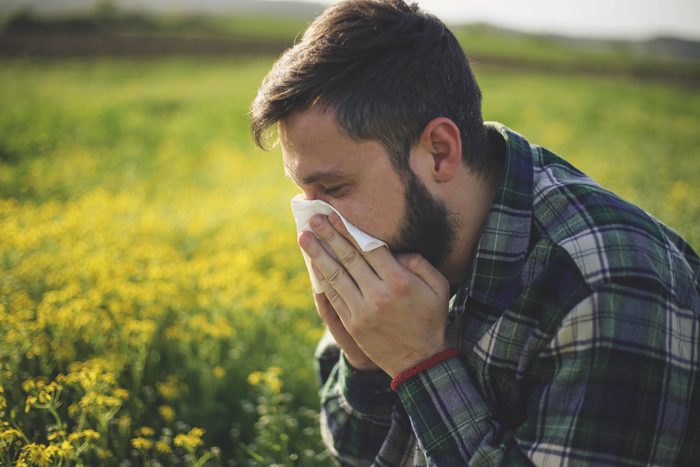If you already suffer from a certain type of allergy, you may be more prone to additional allergies. “People who have allergy tendencies are considered atopic. Basically their immune system is more likely to over-react to the outside world as a perceived threat,” say Shawn Nasseri, MD, ENT-otolaryngologist in Beverly Hills, California. “There is heightened activity by the allergy system which increases local and regional inflammatory hormones called cytokines that are responsible for generalized allergic reactions, face or limb swelling, etc.” As a result of this reaction in the body, allergies can cross react and create even more allergic reactions. Here are the most common allergies that are on the rise and that you should look out for if you already suffer from a certain allergy type.

‘Seasonal’ allergies
Climate change and unpredictable weather patterns worldwide that affect the environment are changing the way we think of “seasonal” allergies. A study conducted by the University of New Hampshire showed that spring is getting longer and coming earlier each year, due to mild winters and less frequent snow falls. So, the transition from winter to spring, known as the “vernal window” is opening sooner. This means seasonal allergies follow suit, coming earlier and lasting longer than ever before. Other research published in The Scientific World Journal found that increasing levels of carbon dioxide and certain types of pollution make pollen more potent, and more likely to affect people with only mild allergies.
If you want to avoid spending spring battling the annoying symptoms of seasonal allergies, such as sneezing, and itchy eyes and throat, limiting your time outdoors on high pollen days can help, says Clifford Basset, MD, founder and medical director of Allergy and Asthma Care of New York and author of The New Allergy Solution: Supercharge Resistance, Slash Medication, Stop Suffering. You can monitor pollen levels in your area on most weather channels and websites. “You should also watch out for windy days, wear sunglasses, a hat, and other protective gear, and be sure to take medication, such as an antihistamine or nasal steroid spray, before symptoms kick in,” he adds. Here are 11 more surprising ways you can stop seasonal allergies in their tracks.

Food
Each year the number of adults and children with some type of food allergy or sensitivity skyrockets. Research published in the journal JAMA Network Open in 2019 found that at least one in every 10 American adults (26 million people) has a food allergy. And the Centers for Disease Control and Prevention (CDC) released a study that shows food allergies among children increased nearly 50 percent between 1997 and 2011.
Scientists are still trying to figure out why food allergies are so prominent today. One main theory is that the over-sanitization of daily life—a concept called the “hygiene hypothesis“—causes helpful gut bacteria to decrease. With fewer infections to fight, the immune system takes up arms against more harmless stimuli.
A simple skin and blood test by your doctor can determine whether you have a food allergy. Foods that tend to cause the most allergic reactions are eggs, milk, peanuts, tree nuts, fish, shellfish, wheat, and soy, according to the American College of Allergy, Asthma and Immunology. The only way to prevent an adverse reaction is to avoid the food or trigger altogether. “You should also create an intervention plan, including how to notice and handle allergic symptoms,” advises Dr. Bassett. “And if your food allergies are severe, always be prepared with an epinephrine auto injector pen.” Watch out for these dangerous myths about food allergies:

Nickel
Nickel is a silvery metal that is found everywhere. Your cell phone? Yes. Kitchen utensils? Yes. Even some of your gold, silver, and diamond high-end jewelry may contain traces of nickel. And of course, the five-cent coin contains 25 percent nickel too. Someone with a nickel allergy may experience an itchy, red, and inflamed rash known as allergic contact dermatitis after their skin comes in contact with the metal. Earlobes, wrists, and the lower abdomen are typically affected.
In recognition of this increasing sensitivity, many manufacturers now offer nickel-free alternatives. If you’re unsure whether your brand-new toaster is made of this irritating ingredient, you can buy a nickel test online or at your pharmacy and do at-home testing. “If you’re allergic, you don’t need to run out and buy a new phone. There are special cases that provide protection,” says Dr. Bassett. “In a pinch, a product that bonds to the metal or coats it can form a protective barrier—even clear nail polish can do the trick sometimes.” Check out these other weird things you can be allergic to.

Drugs
Most people don’t know that they’re allergic to a drug until after having a reaction. About 10 percent of people in the world have some type of an adverse drug reaction, according to the American Academy of Allergy, Asthma, and Immunology. While any medication can technically trigger an allergy, antibiotics like penicillin and amoxicillin and anti-inflammatory medication like ibuprofen and naproxen are common culprits.
“Most drug reactions occur as a ‘rash’ with some hives, but more severe reactions can be dangerous or even life threatening,” warns Dr. Nasseri. “Most of the time management is by avoiding the medications which cause the reactions as they tend to get worse after ever exposure.” A reaction might not occur immediately after just one dose. Some people have a reaction after taking the meds a few times. If you think you may be allergic to a medication, stop taking it and talk to your doctor. (Follow these 10 guidelines that will help you take your medication the right way.)

Pets
Does your kitten or puppy make you sneeze? The Asthma and Allergy Foundation of America estimates that as many as three in 10 people in the United States are allergic to cats and dogs, with cat allergies being twice as prevalent as dog allergies. The good news? Just because you’re allergic to one breed of dog or cat doesn’t mean you’re allergic to all breeds. The bad news? There is no such thing as “hypoallergenic” animals. Most researchers believe an over-sensitive immune system reacting to the pet’s urine, saliva, or dander is what causes an allergy. Similar to most other reactions, symptoms include itchiness, sneezing, and a rash or hives, and the only means of prevention is avoidance. “Try restricting the pet’s access to the allergy sufferer’s bedroom, and better yet, use a room or whole house HEPA air filter to reduce buoyant pet allergen particles in the air,” recommends Dr. Bassett. “When exposure to pets is unavoidable, you can find long-term success with immunotherapies like allergy injections and sublingual allergy drops.” (Check out the best air purifiers for pets to help control dander.)

Insects
Most people have some type of negative reaction after an insect bite or sting, such as swelling and itchiness at the site. Others may experience a more severe whole-body reaction that can be life-threatening. The American College of Allergy, Asthma, and Immunology estimates that about 3 percent of adults die from insect bites each year. Some people experience a more severe reaction like difficulty breathing, swelling beyond the bite or sting site, and abdominal cramping, vomiting, or diarrhea that requires immediate medical attention. The stings of five insects that commonly cause allergic reactions include honeybees, hornets, wasps, yellow jackets, and fire ants. Avoidance is the first and most important step if you have an insect allergy, so make sure you’re always wearing shoes when outdoors and be aware of your surroundings. (Here are the best ways to treat a bug bite.)

Poison oak and ivy
These rash-inducing plants are more widespread than ever before, says Dr. Bassett. “They’re bigger and more potent too,” he says. Many researchers believe global warming is behind the troubling trend, as warmer weather and increased levels of carbon dioxide in the atmosphere allow the plants to grow lager, faster, and stronger, causing a more severe reaction.
If you come in contact with this green (and sometimes red) three-leaf plant, immediately wash all your clothes, your shoes, and even your pets—basically anything that touched the plant. Poison oak typically causes an itchy, red rash within hours of contact and can last anywhere from 5 to 12 days. While most rashes go away without treatment, Dr. Bassett highly recommends applying an over-the-counter cream or calamine lotion that acts as a skin barrier and reduces the itching and pain. You should also consider trying one of these natural home remedies for treating poison oak. In some cases, you may need a prescription medication. If you’re having trouble breathing or swallowing, if the rash is all over your body, or if your eyes are swelling, seek medical attention right away.